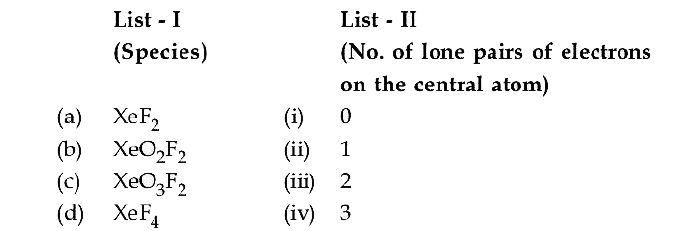Given below are two statements : statements I: P ermutit process is more effeient compared to the synthetic resin method for the softening of water : statements II :Synthetic resin method results in the formation of soluble sodium salts.
In the light of the above statements , choose the most appropriate answer from the options given below :
Both the Statements Iand II are correct
statement I is incorrect but Statement II is corrent
statement I is correct but Statement II is incorrent
Both the Statements I and II are incorrect
To solve the question, we need to analyze both statements provided and determine their correctness.
1. Analyze Statement I:
- Statement I claims that the permutit process is more efficient compared to the synthetic resin method for the softening of water.
- The permutit process involves the use of zeolite (sodium aluminum silicate) which exchanges sodium ions for hardness-causing ions (like calcium and magnesium).
- The synthetic resin method, on the other hand, uses ion-exchange resins to remove hardness-causing ions from water.
- Generally, the synthetic resin method is considered more efficient because it can handle a wider range of water hardness and can regenerate more effectively than the permutit process.
Conclusion for Statement I: Incorrect.
2. Analyze Statement II:
- Statement II states that the synthetic resin method results in the formation of soluble sodium salts.
- In the synthetic resin method, when hardness ions (like Ca²⁺ and Mg²⁺) are removed, they are replaced with sodium ions (Na⁺) from the resin.
- However, this process does not lead to the formation of soluble sodium salts; instead, it results in the exchange of ions and the hardness ions are removed from the water, often forming precipitates or being trapped in the resin.
Conclusion for Statement II: Incorrect.
Final Conclusion:
Both statements I and II are incorrect.
Answer:
Both statements are incorrect.
---
- Statement I claims that the permutit process is more efficient compared to the synthetic resin method for the softening of water.
- The permutit process involves the use of zeolite (sodium aluminum silicate) which exchanges sodium ions for hardness-causing ions (like calcium and magnesium).
- The synthetic resin method, on the other hand, uses ion-exchange resins to remove hardness-causing ions from water.
- Generally, the synthetic resin method is considered more efficient because it can handle a wider range of water hardness and can regenerate more effectively than the permutit process.
- Statement II states that the synthetic resin method results in the formation of soluble sodium salts.
- In the synthetic resin method, when hardness ions (like Ca²⁺ and Mg²⁺) are removed, they are replaced with sodium ions (Na⁺) from the resin.
- However, this process does not lead to the formation of soluble sodium salts; instead, it results in the exchange of ions and the hardness ions are removed from the water, often forming precipitates or being trapped in the resin.
Both statements I and II are incorrect.
Both statements are incorrect.
Topper's Solved these Questions
Similar Questions
Knowledge Check
Match List - I with List- II
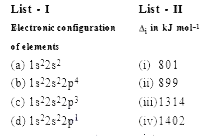
Choose the most appropriate answer from the options given below -A(a)→(ii),(b)→(iii),(c)→(iv),(d)→(i)B(a)→(i),(b)→(iv),(c)→(iii),(d)→(ii)C(a)→(i),(b)→(iii),(c)→(iv),(d)→(ii)D(a)→(iv),(b)→(i),(c)→(ii),(d)→(iii)Match List - I with List- II
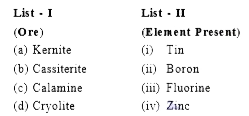
Choose the most appropriate answer from the options given below -A(a)→(i),(b)→(iii),(c)→(iv),(d)→(ii)B(a)→(ii),(b)→(i),(c)→(iv),(d)→(iii)C(a)→(ii),(b)→(iv),(c)→(i),(d)→(iii)D(a)→(iii),(b)→(i),(c)→(ii),(d)→(iv)
Match List - I with List -II

Choose the most appropriate answer from the options given below :
View SolutionMatch List-I with List -II

Choose the most appropriate answer from the options given below:
View SolutionMatch List - I with List - II
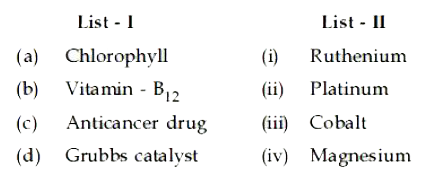
Choose the most appropriate answer from the options given below :
View SolutionMatch List -I with List -II :

Choose the most appropriate answer from the options given below :
View SolutionMatch List I with List II :
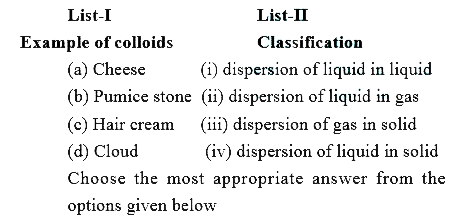
Choose the most appropriate answer from the options given below
View SolutionMatch List - I with List - II.

Choose the most appropriate answer from the options given below :
View Solution
